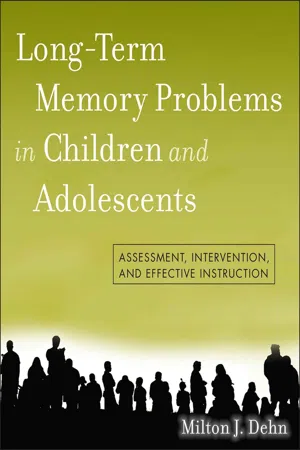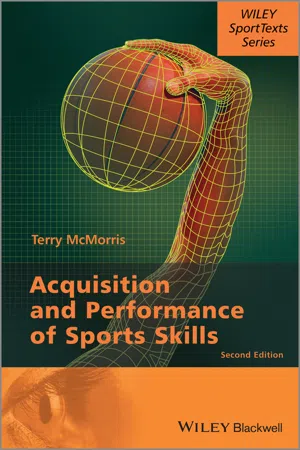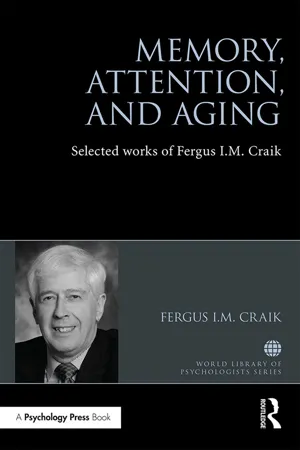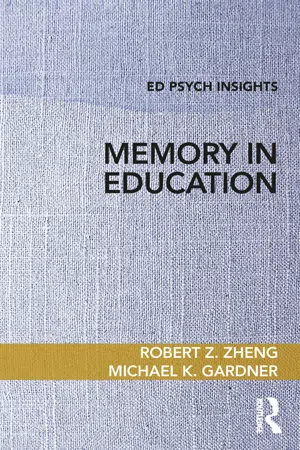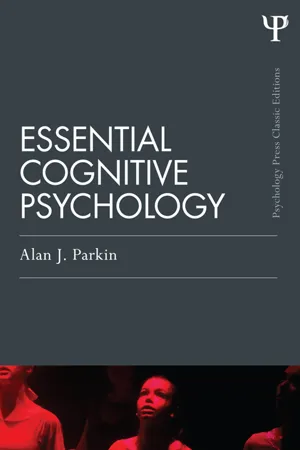Psychology
Short-Term Memory
Short-term memory refers to the temporary storage of information in the brain for immediate use. It has a limited capacity and duration, typically holding around 7 items for about 20-30 seconds. Short-term memory is crucial for tasks like remembering a phone number long enough to dial it or recalling a recent conversation.
Written by Perlego with AI-assistance
Related key terms
6 Key excerpts on "Short-Term Memory"
- eBook - ePub
Long-Term Memory Problems in Children and Adolescents
Assessment, Intervention, and Effective Instruction
- Milton J. Dehn(Author)
- 2010(Publication Date)
- Wiley(Publisher)
When humans are actively processing information, they can consciously influence which incoming information is selected for further processing and storage by selectively attending to it. Thus, attentional processes are crucial learning and memory functions. If an individual wants to learn and remember information, she or he must first pay attention to it. When a person is not interested in or not paying attention to available input, some sort of automated filtering device is presumed to allow only a limited amount of the vast information in the passive sensory store to transfer to Short-Term Memory. In Short-Term Memory, active processing of the input is possible or Short-Term Memory can just passively hold information. Active processing consists mainly of rehearsal that serves to extend the retention interval. Without rehearsal, information will be lost from Short-Term Memory within a matter of seconds. In addition to temporal limits, Short-Term Memory has a typical adult capacity of about seven items or chunks. Much of the information that reaches Short-Term Memory will automatically be encoded into long-term memory processing areas or will automatically activate relevant long-term memory structures. Information that is the focus of attention will be processed further in working memory before being encoded or used to achieve an immediate goal. In common usage, people think of Short-Term Memory as extending for several minutes if not hours. Actually, any information recalled after several seconds is most likely being retrieved from long-term memory. Thus, immediate memory may be a more accurate descriptor of Short-Term Memory. In contemporary memory models, Short-Term Memory is thought to be embedded within the working memory system (Dehn, 2008). In an unconscious mode, Short-Term Memory can operate independently of working memory, but whenever Short-Term Memory content is being managed, working memory is performing that executive function - eBook - ePub
- Terry McMorris(Author)
- 2014(Publication Date)
- Wiley(Publisher)
Many information processing theorists find the claim that attunement to affordances is not a form of memory unacceptable. To the ecological psychologists, however, it is not a form of memory because it does not require the recall of past performance in order to achieve the desired goal. To the ecological psychologists, attunement to affordances is not due to the formation of interconnections between neurons within the brain. It is simply the triggering off of possible perception-action couplings. These are not inter-connected biochemically, in the CNS or PNS, but simply facilitate the recognition of the affordance and/or self-organization. The relationship is similar to the information processing theorists’ claim that familiar stimuli can be processed more quickly than unfamiliar stimuli. This aspect of ecological psychology theory is, for most people, the most difficult to understand or accept. There is undoubtedly a lack of clarity about what is meant by attunement to affordances.Summary
- Memory is the capacity that permits us to benefit from past experiences (Tulving, 1985).
- Motor memory is the persistence of a skill over a period of time.
Sensory information store
- All incoming information is held for a very brief period:
- – information is lost within 0.5 s, unless it is rehearsed
- – rehearsed information is passed to STM
- – SIS may not exist for motor memory.
Short-Term Memory
- Has a limited capacity in terms of time and space.
- All information is lost within 10 s, unless it is rehearsed.
- Can only deal with 7 ± 2 bits of information.
- Capacity problems can be overcome, to some extent, by the use of:
- – chunking (grouping together information to form chunks. each chunk becomes one bit of information)
- – labelling (giving information or chunks names).
- eBook - ePub
Memory, Attention, and Aging
Selected Works of Fergus I. M. Craik
- Fergus I. M. Craik(Author)
- 2016(Publication Date)
- Routledge(Publisher)
Part 1 Short-Term or Primary MemoryThe idea that episodic memory can be divided into two main compartments or processes has appeared in various forms in human experimental psychology over the last 150 years. The basic distinction is between memory for material presented and recalled recently, and material acquired some time ago, with the two stores or systems referred to typically as Short-Term Memory (STM) and long-term memory (LTM). William James (1890) was one of the first writers to describe the two systems explicitly; he distinguished "primary memory" from "memory proper," where primary memory referred to information just experienced and still maintained in conscious awareness, as opposed to stored information that must be retrieved in order to be re-experienced. The notion of two different systems emerged again strongly with the advent of information-processing models of attention and perception. For example, Broadbent's (1958) model had a pre-attentive "s-system" and a limited capacity "p-system." Incoming material could be held briefly in the s-system before selection by the attentional filter mechanism, then identified and experienced consciously in the p-system, and if necessary recycled through the s-system. This last procedure enabled the participant to rehearse the material until a response was required.Research on STM was further boosted by articles written by John Brown (1958) in England and by Lloyd and Margaret Jean Peterson (1959) in the US. Both studies showed that retention of small amounts of material fell off drastically after only a few seconds of interfering activity. For example the Petersons found that memory for three-letter stimuli fell to 10 percent after 18 seconds of counting backwards. Murdock (1961) followed these demonstrations by showing that three words were forgotten at the same rate as three letters, and therefore concluded that the appropriate unit of storage in STM is "the chunk"—any meaningfully integrated unit of information. The growing enthusiasm for a separate short-term store was dampened, however, by Melton (1963) who argued that the hallmarks of memory in general were (a) learning to increase retention and (b) interference - eBook - ePub
- Robert Z. Zheng, Michael K. Gardner(Authors)
- 2019(Publication Date)
- Routledge(Publisher)
17 The results showed that the pursuit rotor task did not interfere with the verbal version of the Brooks task but interfered significantly with the visual version of the Brooks task. In this case both the visual Brooks task and the pursuit rotor task were competing for the limited resources available in the visuo-spatial sketchpad.In a more recent presentation of the working memory model, Baddeley has added a new component: the episodic buffer.18 The episodic buffer allows the central executive a way to combine visual, spatial, and verbal information to form complete percepts of the type we might encounter in our everyday experience. Clearly something like a trip to the coffee shop involves more than separate visual and verbal information. It involves the amalgamation of sight, sound, smell, and taste. The episodic buffer is where this type of information is stored and manipulated.In conclusion, short-term or working memory is where information is held and manipulated for relatively brief periods of time, say 20 seconds to a few minutes. Here it can be connected with already known information and transformed in various ways. The goal is to prepare at least some of this information for a more permanent type of storage.Long-Term Memory
Long-term memory differs in significant ways from short-term or working memory. It is extremely large, large enough to contain all of the memories we’ve accumulated over a lifetime. Some psychologists think it is infinite in capacity. Others think there must be some limits as there are only a finite number of neurons in our brains and only so many ways that they can be interconnected. From a practical point of view, any limitations of long-term memory are not due to its size. It is big enough to do its job for our entire lives.Long-term memory is also of essentially unlimited duration. You can probably recall moments from your childhood, even if you are well into adulthood. The question of whether everything you ever learned is still in your long-term memory is a difficult one. Two possibilities exist: (a) Everything is still in long-term memory, but you may not be able to access the information at the current time; or (b) some of the information has faded away with the passage of time and is no longer in long-term memory. When Loftus and Loftus asked 169 individuals which possibility they thought was true, 84% chose the first possibility and 14% chose the second possibility (2% gave some other answer).19 So why do people, especially psychologists, favor the first position? One reason is due to a series of studies performed by Wilder Penfield and his associates.20 ,21 ,22Penfield was a neurosurgeon, and during surgery to remove regions of the brain that were producing epilepsy, he would stimulate the cortex of patients (who were awake at the time). These patients often reported vivid memories from their past (e.g., “That was Uncle Louis playing the piano at a Christmas party when I was eight.”) that they were hitherto unable to recall. This research led people (including Penfield) to conclude that almost everything we are exposed to is stored in long-term memory, although we may not be able to access it at a given point in time. Loftus and Loftus cast doubt on this interpretation, however.19 - eBook - ePub
- Alan J. Parkin(Author)
- 2014(Publication Date)
- Psychology Press(Publisher)
Sequences of these different types of string were presented and it was found that the number of errors in sequence repetition decreased systematically as strings closer in their approximation to English were used. This finding reflects the chunking that subjects were able to do, e.g. remembering “ERE” as opposed to “E”, “R”, “E”.The above findings demonstrate that the capacity of short-term store will vary depending on the nature of the information being remembered. This finding illustrates a fundamental problem in attempting to measure human memory capacity. Artificial storage systems such as floppy discs, compact discs, and magnetic tapes, have measurable fixed capacities because information is fed into them in the form of basic information units (e.g. “bytes” of information). In order to measure the capacity of human memory we would first need some similar method for reducing any to-be-remembered information into basic units. This may be possible in the future but, at present, our lack of a basic unit for measuring the size of different pieces of information put into memory precludes any attempt to measure memory capacity accurately.Long-term recencyConsider the following experiment. Subjects are presented with nine pairs of words to learn. Each pair is presented for 2 seconds followed by a period of distracting activity (mental arithmetic). After the last pair there is a further period of distraction before recall of the nine pairs is attempted. In version ‘A’ the period of distraction between each pair is 4 seconds followed by a final distraction period of 12 seconds. In version ‘B’ the period of distraction between each pair is 12 seconds and the final distraction period is 36 seconds. - eBook - ePub
- Alan J. Parkin(Author)
- 2013(Publication Date)
- Psychology Press(Publisher)
Sequences of these different types of string were presented and it was found that the number of errors in sequence repetition decreased systematically as strings closer in their approximation to English were used. This finding reflects the chunking that subjects were able to do, e.g. remembering ‘ERE’ as opposed to ‘E’, ‘R’, ‘E’.The above findings demonstrate that the capacity of short-term store will vary depending on the nature of the information being remembered. This finding illustrates a fundamental problem in attempting to measure human memory capacity. Artificial storage systems such as floppy discs, compact discs, and magnetic tapes have measurable fixed capacities because information is fed into them in the form of basic information units (e.g. ‘bytes’ of information). In order to measure the capacity of human memory we would first need some similar method for reducing any to-be-remembered information into basic units. This may be possible in the future but, at present, our lack of a basic unit for measuring the size of different pieces of information put into memory precludes any attempt to measure memory capacity accurately.Long-term recencyConsider the following experiment. Subjects are presented with nine pairs of words to learn. Each pair is presented for 2 seconds followed by a period of distracting activity (mental arithmetic). After the last pair there is a further period of distraction before recall of the nine pairs is attempted. In version ‘A’ the period of distraction between each pair is 4 seconds followed by a final distraction period of 12 seconds. In version ‘B’ the period of distraction between each pair is 12 seconds and the final distraction period is 36 seconds.
Learn about this page
Index pages curate the most relevant extracts from our library of academic textbooks. They’ve been created using an in-house natural language model (NLM), each adding context and meaning to key research topics.
